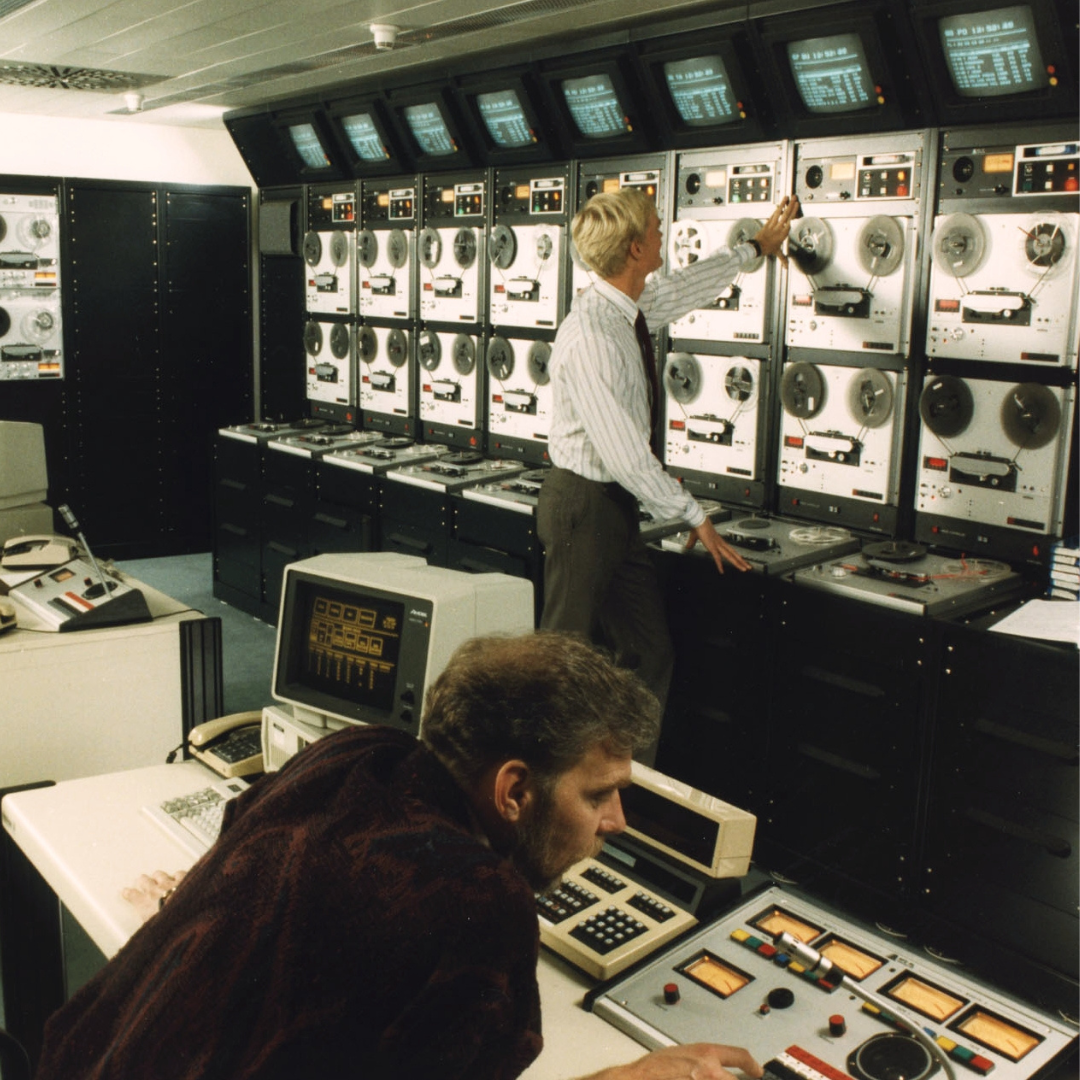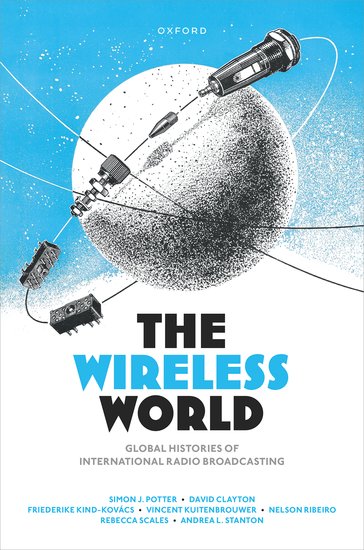A global history of radio broadcasting
 Fortepan / Fortepan
Fortepan / Fortepan 
Published by: Oxford University Press
 Fortepan / Fortepan
Fortepan / Fortepan The Wireless World charts the global history of international radio broadcasting from its origins in the early twentieth century until the present day. States have played a preeminent role in this form of radio broadcasting, claim the volume’s authors (p. 14), who additionally acknowledge that their focus foregrounds particular states whose budgets stretched to cover this expensive practice (p. 19). Ultimately, the authors argue that the wireless world was not an “untrammeled, unstructured, and otherworldly ether” (p. 5), but instead a site of human activity, which they set out to map in order to understand “the relationships of dominance and hierarchy that international broadcasting helped create and sustain” (p. 31). These relationships replicated, and therefore can be analyzed to reveal, “many of the imperfections and the limitations of the physical world” (p. 5). By undertaking this analysis, The Wireless World’s authors contribute to literature on cultural diplomacy and international relations on the one hand, and to media history and science and technology studies on the other.
Chapter One provides an explanation of the volume’s central term, “the wireless world”. The authors then turn to the technologies of radio broadcasting in Chapter Two and then, in the following chapter, to the shifting historical role played by institutions and states. In Chapter Four, they zoom in on international broadcasters’ activities during conflicts, juxtaposing this with a chapter on how radio has historically been used by different constituencies to foster forms of internationalism. The final three chapters analyze the content of international radio broadcasts, the experiences of listeners, and the soundscapes of the wireless world respectively. The authors therefore combine traditional avenues of inquiry (for example into international radio and statecraft), with less explored topics (for example reflecting on soundscapes, which have hitherto been largely the preserve of musicologists and cultural theorists). Their decision to break radio history down into these different categories is welcome, as it underscores the complex configuration of technologies, actors and behaviors of which, they argue, radio is ultimately assembled. Each chapter introduces its central theme before illustrating its point with two case studies drawn from members of the collective’s archival research. These are integrated smoothly, and the collectively authored volume thus reads well overall.
The authors’ call to think about postwar international broadcasting through the prism of decolonization is stimulating. It contains the possibility of understanding the radio output and aspirations of actors in the “capitalist,” “socialist,” and “developing” world (to borrow the official Eastern bloc terminology of the period) as a result of logics beyond a communist/ anti-communist binary. The authors are right that such a binary has indeed inflected, and perhaps even straightjacketed, some of the scholarship on Cold War radio to date (p. 220). In their attention to listener letters, and their reflections upon how colonial-era infrastructures were repurposed and redeployed by journalists and politicians in newly independent states, the authors show how colonial subjects and postcolonial citizens both contributed to and challenged the organizing principles of the wireless world.
in showing the biggest possible stakes of actions taken in media centers and the way in which connections could indeed be fostered or altered by those in the “peripheries,” this work opens an important discussion about how we should map media geographies in the first place, and who their relevant actors might be.
Many of these organizing principles were more or less in place by the 1930s, this volume argues (p. 20). In their call to understand international broadcasting during the Cold War both in terms of the Second World War and what went before, the authors expose the earlier (imperial, interwar, and wartime) legacies that shaped the nascent Cold War. They argue convincingly that, despite “new targets during the Cold War, […] clear continuities can be found in terms of institutional structures and mechanisms of official influence and direction” shaping international broadcasters in both “the Western and Eastern blocs” (p. 82). Finding parallels between the period of Nazi occupation and the Communist era is a device structuring what Agata Zysiak has called “neo-totalitarian” accounts of the Cold War in Central and Eastern Europe.1 Here, the authors’ “global” framework allows them to show that earlier practices mattered for the way radio was conceived of, controlled, and deployed by states at the time beyond the socialist East as well.
If the book’s stated aim of revealing the “global histories of international radio broadcasting” certainly, and profitably, moves beyond examining the British Broadcasting Corporation’s (BBC’s) remit and ramifications in the United Kingdom, then the preponderance of case studies do, nevertheless, draw from the BBC’s archive. This means that the book extends the reader’s horizons, certainly, but does not necessarily alter their existing radio geographies. Many of the phenomena the authors discuss will not be completely new to the reader, but are nevertheless placed into broader international context: readers will learn about Marconi’s work developing radio technology, for example, but also of his involvement in and belief in the potential of Radio Vatican broadcasts (p. 13); they will encounter on several occasions the broadcasts of Lord Haw-Haw, but also read about his postwar trial and punishment alongside that of his fellow propagandist in the Pacific arena, “Tokyo Rose” (p. 115). This is not a global history of radio upending, therefore, earlier scholarship into where media power and media capital reside but, in showing the biggest possible stakes of actions taken in media centers and the way in which connections could indeed be fostered or altered by those in the “peripheries,” this work opens an important discussion about how we should map media geographies in the first place, and who their relevant actors might be.
The role allocated to Central and Eastern Europeans in the wireless world might be questioned —given the venue in which this review appears. Discussed with nuance and subtlety as listeners in Chapter 7, the region’s inhabitants are nevertheless absent from analyses of those actively contributing to the cacophony of the wireless world. The one “contribution” the region is detailed as making to the ether here is the sound of jamming (see pp. 258-265). This makes sense on account of the content of the primary archive used here to understand the region—files generated by the American-sponsored broadcaster Radio Free Europe/Radio Liberty (RFE/RL). These understandably focus on the broadcaster’s listenership and the attempts to block elements of its programming undertaken by the states to which it was directed. But this archive has the additional tendency to represent inhabitants of the region as “captives,” for example, or mute in light of their inability to vote in multiparty, democratic elections. Ironically, as Melissa Feinberg has shown, many inhabitants of Eastern Europe themselves contributed to such institutional discourses and understandings on the part of RFE, which does not, however, make them any more accurate representations of media usage and daily life in Eastern Europe.2 In their decision here to understand the region through the prism of RFE/RL, the authors do end up replicating some of the insistences upon Eastern passivity which characterized the station’s Cold War-era research.
The foregrounding of Eastern Europeans as “clandestine” listeners, moreover, overlooks quite how boisterous some voices from the region actually were. In recent work, cited by the authors (though only published later, so it is not clear whether they could have known the final details of its contents), Kristin Roth-Ey shows how, during the 1960s, Radio Moscow became “by some metrics, the largest [international] broadcaster in the world”.3 In the excellent analysis that follows this claim, Roth-Ey likewise argues that “radio’s moment and the ‘Third World’ moment collided,” showing masterfully to what effect.
Prague played host to members of the Italian Communist Party, who broadcast internationally from there for several decades, all the while pretending that its reporters were really speaking from a secret location in Italy.
Complementing the work of Potter et al with the output (and sizeable audiences) of stations such as Radio Moscow—alongside smaller, but strikingly well-funded and correspondence-rich international broadcasters across the former Eastern bloc—recognizes the contributions made by members of “roughly one third of the world’s population” who inhabited “the socialist world at the height of its expansion,” and who are often overlooked in “global” studies claiming to account for shifts taking place during the Cold War on a global scale.4 It reveals how Central and Eastern European states were involved in international projects of their own, which combined questions of statecraft, sovereignty, and media broadcasting in sometimes quite startling ways. For instance, Prague played host to members of the Italian Communist Party, who broadcast internationally from there for several decades, all the while pretending that its reporters were really speaking from a secret location in Italy. Reporters from the Czechoslovak state’s international service, Radio Prague, in another example, were instrumental in the attempt to restore Kwame Nkrumah to power in Ghana in 1968.5 If this international broadcaster provided a “front” while its reporters received security forces training in Prague, then this “front” left its own legacy of scripts and listener feedback, which arguably tell us as much about media and decolonization in the 1960s as they do about Eastern bloc propaganda, which is perhaps what the Czech Radio archive has more frequently been understood to contain.
A history as ambitious as The Wireless World simply cannot tell every story, of course. In its ambition, and its attention to the technologies, content, politics and cultures of international radio broadcasting throughout the twentieth century, The Wireless World indeed excels. By showing how social structures and relationships spanning continents could be constructed through the sometimes-ritualized use of radio technologies, it opens exciting new avenues of inquiry for radio scholars of Central and Eastern Europe. It is now for those scholars to tune in to the contributions made by the region’s inhabitants to the overall clamor of the wireless world.
Rosamund Johnston is a REWIRE postdoctoral fellow at the Research Center for the History of Transformations (RECET), University of Vienna. She is the author of Red Tape: Radio and Politics in Czechoslovakia, 1945-1969 which is shortly to appear with Stanford University Press. Her work has featured in Central European History, the Journal of Cold War Studies, East Central Europe, Harvard Ukrainian Studies, Scottish newspaper The National, and on public broadcaster Czech Radio. Johnston is the author of one book of public history, Havel in America: Interviews with American Intellectuals, Politicians, and Artists, released by Czech publisher Host in 2019. She is currently researching the global history of Czechoslovakia between 1954 and 1994 through its arms trade.

The Wireless World: Global Histories of International Radio Broadcasting
Published by: Oxford University Press
1 Zysiak, Agata. Limiting Privilege: Upward Mobility within Higher Education in Socialist Poland. West Lafayette: Purdue University Press, 2024.
2 Feinberg, Melissa. Curtain of Lies: The Battle over Truth in Stalinist Eastern Europe. New York: Oxford University Press, 2017.
3 Roth-Ey, Kristin. “The Airwaves: How Do You Listen to Radio Moscow? Moscow’s Broadcasters, ‘Third World’ Listeners, and the Space of the Airwaves in the Cold War.” Socialist Internationalism and the Gritty Politics of the Particular: Second-Third World Spaces in the Cold War. Ed. Kristin Roth-Ey. London: Bloomsbury Academic, 2023. pp. 39–58, p. 40.
4 Mark, James, Kalinovsky, Artemy & Marung, Steffi (eds.). Alternative Globalizations: Eastern Europe and the Postcolonial World. Bloomington, IN: Indiana University Press, 2020, p. 2.
5 Telepneva, Natalia. “Saving Ghana’s Revolution: The Demise of Kwame Nkrumah and the Evolution of Soviet Policy in Africa, 1966–1972” in Journal of Cold War Studies (2019); Vol. 20, No. 4: pp. 4–25 and Zídek, Petr. Češi v srdci temnoty: Sedmadvacet historických reportáží o prvním čtvrtstoletí vlády komunistů. Prague: Universum, 2013.
